Table of contents
Tofu is a tasteless, protein-rich product made from soybeans.
Use in the kitchen
Tofu is a product made from curdling soy milk. Tofu is originally a Chinese food, but it is now used in numerous Asian dishes. In Western cuisine, it is popular as a protein-rich substitute for meat and fish, especially in vegetarian and vegan cuisine. There are different types of tofu that differ in their consistency. Silken tofu is very soft and tender because it has a high water content and is unseasoned. It is particularly popular for making desserts. Firm tofu contains very little water and can easily be cut into slices or cubes with a knife. Firm tofu can be bought plain, seasoned or smoked.
Can you eat tofu raw? Since tofu is made from boiled soy milk, tofu is no longer a raw food product. Tofu is therefore never really 'raw'. It is possible to eat tofu without heating it first. Since tofu is made by boiling the soybeans, the heating destroys the toxic lectin that is in the soybeans. However, tofu is usually eaten boiled, fried or grilled. Tofu can be made even crispier if you carefully squeeze out the remaining water in a clean tea towel before frying. Diced tofu is also used as a soup garnish, traditionally in a miso soup , for example.
Tofu is relatively tasteless, which is why it is often heavily seasoned or marinated. In addition to seasoning sauces such as soy sauce (tamari) or sambal oelek, spices such as curry or paprika , as well as garlic or ginger , also go well. Tofu also tastes delicious in a teriyaki marinade . It goes well with all kinds of vegetable dishes, rice dishes, casseroles or as a topping on salads.
Because of its neutral taste, it can be used not only for savory dishes, but also for sweet dishes. Silken tofu is ideal for this. You can easily make a delicious chocolate cream from creamy blended silken tofu, melted dark chocolate and a little maple syrup or pureed dates .
own
You can also make your tofu. To do this, you need to soak the soybeans in water overnight. Then drain the water and rinse the beans well. Puree the beans together with 2 liters of water until fine. Put the soybean puree in a large pot and bring to the boil, stirring constantly. Then simmer for 10 minutes at a low heat, stirring frequently. Allow to cool slightly and strain through a nut milk bag or strainer and squeeze well. Put the soy milk back into a pot and heat to approx. 73 °C. 2
Dissolve nigari (a Japanese coagulant made from sea water) in 50 ml of hot water and carefully stir into the soy milk. Turn off the stove, put the lid on and leave to stand for 15 minutes. Place the tofu press in a flat bowl and line it with a thin layer of gauze. In the meantime, the soy protein should have separated from the whey. Skim off the soy protein and pour the mixture into the tofu press and put the lid on. For firm tofu, you need to weigh down the lid with a weight. Wait at least 20 minutes or until the block has cooled completely. Then carefully wash the tofu block under running water. Covered with salt water, the tofu will keep in the fridge for around a week. 2
Instead of nigari, you can also use food-grade magnesium chloride or calcium sulfate 2.7 . Both can be purchased in online shops and sometimes in pharmacies and drugstores.
Vegan recipe for crispy tamari tofu
Ingredients (for 2 people): 200 g tofu, 1 tbsp corn starch , 2 tbsp tamari or soy sauce , 1 tbsp lemon juice , 2 cm freshly grated ginger , 1 tbsp sesame seeds .
Preparation: Wrap the tofu in a clean kitchen towel and squeeze it out gently. Then cut the tofu into cubes. Mix the cornstarch, tamari (soy sauce), lemon juice and freshly grated ginger in a sealable container. Put the tofu cubes in the marinade, close the lid and shake the container until the marinade is evenly distributed. Put the marinated tofu cubes in a frying pan and fry. After about 2 minutes, sprinkle the sesame seeds on top and stir. Fry the tofu cubes until golden brown on all sides.
Vegan recipes with tofu can be found under the note: "Recipes that have the most of this ingredient".
| Not only vegans or vegetarians should read this: Vegans often eat unhealthily. Avoidable nutritional mistakes . |
Purchasing - Storage
Tofu can usually be found in the range of large supermarket chains such as Coop , Migros , Denner , Volg , Spar , Aldi , Lidl , Billa , Rewe , Edeka or Hofer , sometimes also in organic quality. You can also buy organic tofu in organic supermarkets such as Denn's Biomarkt or Alnatura .
The availability of tofu in the supermarkets mentioned varies depending on the size of the store, catchment area, etc. If you are interested, click on our recorded food prices for the DA-CH countries (above under the ingredient image). There you will find current prices from various supermarkets and their price development.
Storage tips
Opened tofu should be stored in an airtight container in the refrigerator. This way it will last for around a week. Unrefrigerated it will only last for 1 to 2 days at most. As soon as the tofu is greasy or starts to smell, you should no longer eat it. 8 Packaged tofu should be stored in the refrigerator. This way it will last well beyond the best-before date printed on the package.
Ingredients - Nutritional values - Calories
Tofu (organic) contains 151 kcal per 100 g. The fat content is 8.1 g/100g. With 12 g of protein per 100 g of tofu, which corresponds to 25% of the daily requirement, tofu is a protein-rich food. 1
Does tofu have carbohydrates? Tofu contains carbohydrates, but only 6.9 g per 100 g of tofu. 1
Magnesium is abundant in tofu, with 228 mg/100 g. This corresponds to 61% of the daily requirement. Quinoa (197 mg/100 g) and buckwheat (231 mg/100 g) have similarly high magnesium values. Bananas , which are often referred to as a 'good' magnesium source, only provide 27 mg per 100 g. 1
The protein-rich tofu contains all essential amino acids. 100 g of tofu contains 0.12 g tryptophan and 0.40 g threonine . This corresponds to 48 and 43% of the daily requirement respectively. Dried porcini mushrooms have a high tryptophan content with 1.5 g/100 g, which corresponds to 589% of the daily requirement. Foods containing threonine are brewer's yeast (2.7 g/100g) and spirulina (3.0 g/100g), although these are only consumed in small quantities. 1
There is also 0.89 mg of manganese per 100 g of tofu, which corresponds to 44% of the daily requirement. Miso (soybean paste) contains a comparable amount of 0.86 mg/100g. Tempeh , on the other hand, has 1.3 mg/100g. Soybeans have higher values at 2.5 mg/100 g and chickpeas at 2 mg/100 g. 1
Does tofu contain vitamin K? Tofu contains 4.6 µg/100g of vitamin K , which corresponds to 6% of the daily requirement. Green vegetables such as kale (705 µg/100g) or spinach (483 µg/100g) have significantly higher levels of vitamin K. 1
Unsaturated fatty acids: The ratio between omega-6 and omega-3 fatty acids in tofu is 7:1 (see ingredient tables and link in the box above). The Federal Office of Public Health ( FOPH ) recommends that the value should not exceed 5:1 (LA:ALA) on average. However, most people consume significantly more omega-6 than omega-3 fatty acids. Erb-Müesli, for example, can correct this. If you enter the "sort by health values" option in the ingredients list, you can select healthy ingredients or those that compensate for a deficiency. The ratio is reversed for linseed, for example; it contains less potentially inflammatory LA (omega-6) and more anti-inflammatory omega-3 in the form of ALA. You can find out more about this in the link to olive oil , where we explain this in detail.
You can find all the ingredients of tofu, how much it covers your daily needs and comparison values with other ingredients in our nutrient tables below the ingredient image.
Health Benefits
Tofu is a high-protein food with 12 g of protein per 100 g. It contains all essential amino acids, but in smaller amounts than soybeans or tempeh . Tofu is a good vegetarian and vegan source of protein with few calories, no gluten and no cholesterol.
Soybeans and soy products such as tofu contain isoflavones. These are plant substances whose chemical structure is similar to female sex hormones (estrogens). Due to the hormonal effect of the isoflavones in soy products, their consumption is repeatedly discussed critically. For example, there is widespread concern that soy consumption could increase the risk of breast cancer. The current study situation regarding the involvement of soy isoflavones in the development of breast cancer is contradictory. While cell and animal studies indicate negative effects of soy consumption, population studies showed an opposite effect. However, epidemiological studies from Asia give the all-clear, as Asian women who eat a lot of soy products compared to European women are less likely to develop breast cancer. A 2022 meta-study showed that the consumption of isoflavones in soy products even reduces the risk of breast cancer in women before and after menopause. 12 Which specific amounts and components are responsible for the observed anti-cancer effects are still the subject of research. Soy isoflavones do not appear to act like estrogen, but rather exhibit antiestrogenic properties. Since the majority of breast cancer cases are hormone receptor positive, isoflavones may act as a potential anti-cancer therapeutic. 13
However, the Federal Institute for Risk Assessment (BfR) advises against taking isoflavone preparations. However, the BfR does not speak out against the moderate consumption of foods containing isoflavones. 14
Dangers - Intolerances - Side effects
Tofu consists of soy, which is one of the 14 main allergens. 4 People with a soy allergy should therefore avoid eating tofu. People who are allergic to flower pollen should also be careful, as cross-allergies can occur. 5
Tofu is made from boiled soy milk and therefore no longer contains toxic lectins. This is why tofu can be eaten without prior heating (you can find out more about this in the link to the ingredient soybeans ).
Ecological footprint - animal welfare
Tofu is a protein-rich food with a significantly lower ecological footprint and water consumption than animal protein sources such as beef or pork, eggs and cheese. 15 However, the amount of carbon emitted and the amount of water required differ considerably depending on the country of origin and the method of cultivation (see also soybeans for more information). 16 Since tofu is a processed product, its production requires more resources (in the form of water, CO 2 and land) than the soybeans alone. 15 In addition, liquid waste products, so-called tofu dregs, are produced during the production of tofu. They are also called soy pulp (okara ) and are used as a binding agent or egg substitute. This liquid is created by washing and cooking the soybeans and is sometimes still very rich in nutrients. In Asian countries such as Indonesia in particular, this liquid is often disposed of directly as wastewater without further treatment. This can have a negative impact on the environment due to the high nutrient content. 17 However, there are now initiatives to integrate these waste products into animal feed or to use them as an energy source in the form of biogas. 17,18
Italy and France are the main players in European soybean production, but Austria and Germany also grow soy on a large scale. 19 So pay attention to the origin, as the transport routes for regional tofu are correspondingly short. In addition, soybeans for organic tofu from European production are not genetically modified, in contrast to soybeans that end up as animal feed. 3,11
Worldwide distribution - cultivation
Tofu originated in China. 9 It is popular throughout Asia as a protein food and is part of many Asian dishes. Tofu began to be produced in the USA and Europe in the late 19th century, with commercial distribution increasing during the early 20th century. 10
Industrial production
The industrial production of tofu is similar to the preparation at home (see chapter on making your own). For large-scale production, the soybeans are washed and placed in water to swell. The beans are then pureed and boiled with water. After sieving the shells and fibers, the soybean juice or soy milk remains. The coagulant (nigari, magnesium chloride or calcium sulfate) is then added to the soy milk. The soy milk begins to coagulate, so that the whey and soy protein separate. The soy protein is put into perforated press molds and then pressed until a more or less solid block is formed. This is then cut into smaller blocks and cooled in a basin of clear water. The tofu can then be packaged or smoked or seasoned or processed into tofu meat substitutes. 6,7
Further information
Tofu is made from soybeans. This should not be confused with seitan, which is made from wheat protein.
Alternative names
Tofu is also known as bean curd, soy curd or bean cheese. In English it is called either bean curd, soybean curd cheese or tofu.

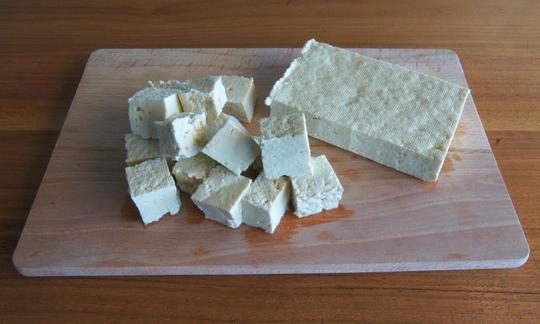

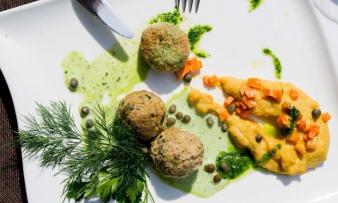
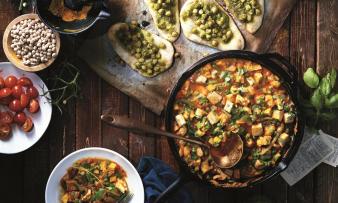
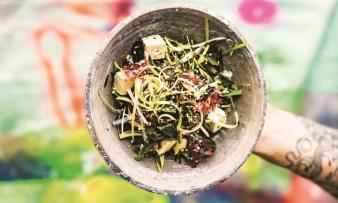
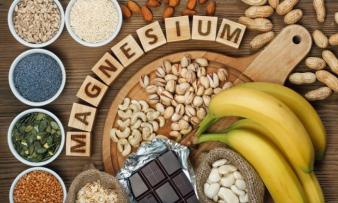




Comments